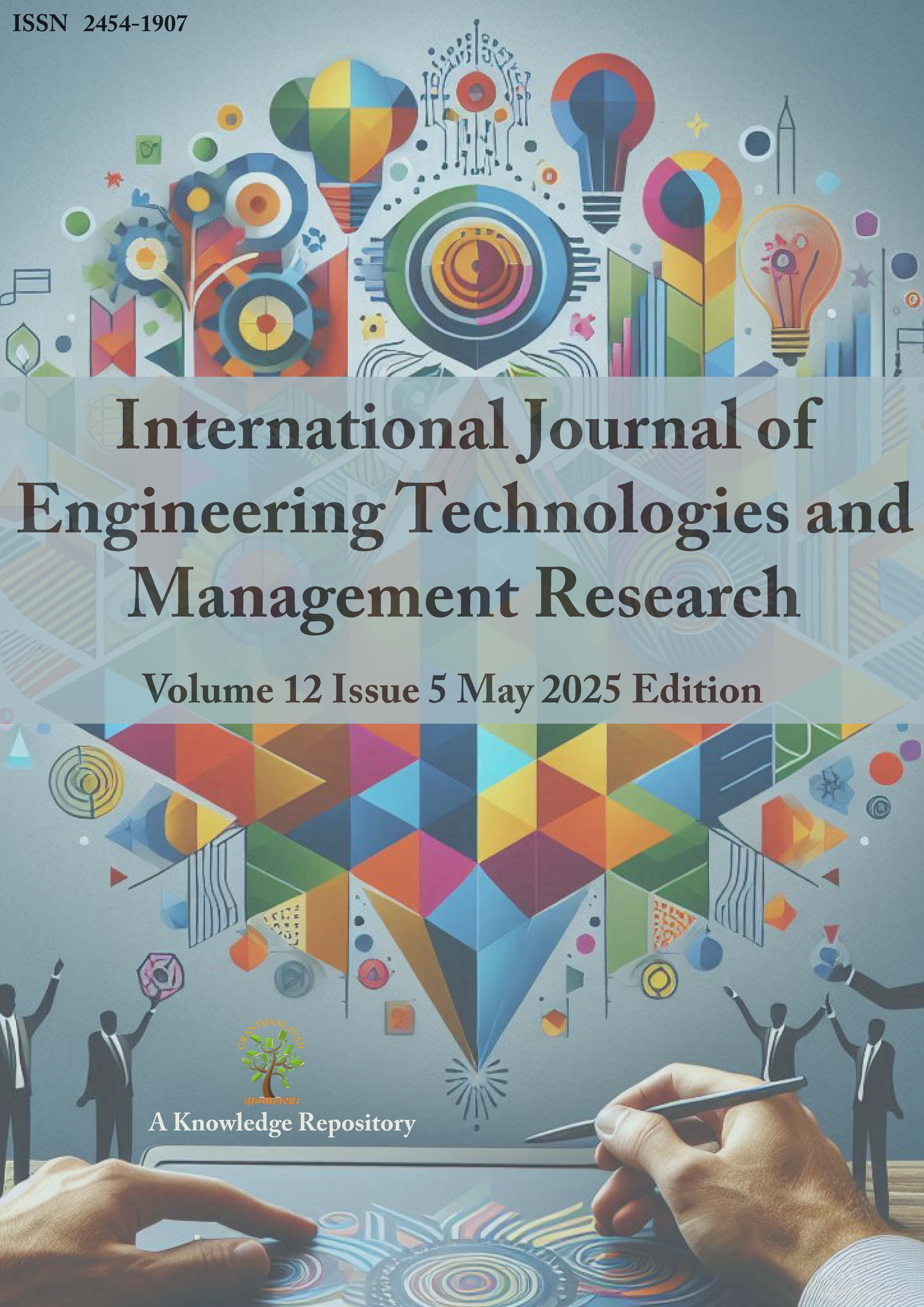A COMPREHENSIVE REVIEW ON VIRTUAL TRIAL ROOMS: INTEGRATION OF AR, AI, AND 3D TECHNOLOGIES FOR ENHANCED E-COMMERCE EXPERIENCE
DOI:
https://doi.org/10.29121/ijetmr.v12.i5.2025.1615Keywords:
Virtual Trial Room, Augmented Reality, Virtual Reality, 3d Fitting, E-Commerce, Body ScanningAbstract
Online shopping has become an everyday convenience, especially in the fashion and apparel industry. Yet, one persistent drawback remains—the inability for customers to try on clothes before making a purchase. This often leads to issues with fit, style mismatches, and high return rates, affecting both customer satisfaction and business operations. Virtual Trial Rooms (VTRs) have emerged as a promising solution, allowing users to virtually try on garments using technologies like Augmented Reality (AR), Artificial Intelligence (AI), and Computer Vision. This paper explores how VTRs work, the technologies behind them, and their real-world applications. It also looks at how VTRs are making online shopping more accurate, hygienic, and sustainable, especially after the COVID19 pandemic. By comparing existing systems, we highlight their strengths and current limitations while pointing out key areas for future development. As this technology continues to evolve, it has the potential to significantly transform the way people experience fashion retail online.
Downloads
References
Adikari, S. B., Ganegoda, N. C., Meegama, R. G., & Wanniarachchi, I. L. (2020). Applicability of A Single Depth Sensor in Real‐Time 3d Clothes Simulation: Augmented reality virtual dressing room using Kinect sensor. Advances in Human‐Computer Interaction, 2020(1), 1314598. https://doi.org/10.1155/2020/1314598
Alzamzami, O., Ali, S., Alkibsi, W., Khan, G., Babour, A., & Bitar, H. (2023). Smart Fitting: An Augmented Reality Mobile Application for Virtual Try-on. Romanian Journal of Information Technology and Automatic Control, 33(2), 103–118. https://doi.org/10.33436/v33i2y202308
Battistoni, P., Di Gregorio, M., Romano, M., Sebillo, M., Vitiello, G., & Brancaccio, A. (2022). Interaction Design Patterns for Augmented Reality Fitting Rooms. Sensors, 22(3), 982. https://doi.org/10.3390/s22030982
Biswas, A., Dutta, S., Dey, N., & Azar, A. T. (2014). A Kinect-Less Augmented Reality Approach to Real-Time Tag-Less Virtual Trial Room Simulation. International Journal of Service Science, Management, Engineering, and Technology (IJSSMET, 5)(4), 13–28. https://doi.org/10.4018/ijssmet.2014100102
Boonbrahm, P., Sewata, L., & Boonbrahm, S. (2015). Transforming 2D Human Data Into 3d Model for Augmented Reality Applications. Procedia Computer Science, 75, 28–33. https://doi.org/10.1016/j.procs.2015.12.193
Canva. (n.d.). Design Anything. Publish Anywhere. Diagram Created Using Canva for Fig. 1: "A General Workflow of a Virtual Trial Room System, Starting from User Input to the Final Virtual Try-on Experience Using Augmented Reality and 3D Simulation Techniques." Retrieved from https://www.canva.com/
Dias, J., Chouhan, D., Churi, P., & Parab, P. (2022, April). Augmented Reality-Based Virtual Dressing Room Using Unity3D. In Proceedings of the 7th International Conference on Innovations and Research in Technology and Engineering (ICIRTE2022), organized by VPPCOE & VA, Mumbai-22, India. https://doi.org/10.2139/ssrn.4111818
Douglas, D. B., Wilke, C. A., Gibson, D., Petricoin, E. F., & Liotta, L. (2017). Virtual Reality and Augmented Reality: Advances in Surgery. Biology Engineering & Medicine, 3(1), 1–8. https://doi.org/10.15761/BEM.1000131
El-Nahass, M. (2021). The Impact of Augmented Reality on Fashion and tExtile Design Education. International Design Journal, 11(6), 39–52. https://doi.org/10.21608/idj.2021.204886
Erra, U., Scanniello, G., & Colonnese, V. (2018). Exploring the Effectiveness of an Augmented Reality Dressing Room. Multimedia Tools and Applications, 77, 25077–25107. https://doi.org/10.1007/s11042-018-5758-2
Jadhav, O., Patil, A., Sam, J., & Kiruthika, M. (2021). Virtual Dressing Using Augmented Reality. In ITM Web of Conferences (Vol. 40, p. 03028). EDP Sciences. https://doi.org/10.1051/itmconf/20214003028
Jayamini, C., Sandamini, A., Pannala, T., Kumarasinghe, P., Perera, D., & Karunanayaka, K. (2021). The Use of Augmented Reality to Deliver Enhanced User Experiences in Fashion Industry. Lecture Notes in Computer Science, 12936.
Joshi, T. P., Yadav, A. K., Chhetri, A., Agrahari, S., & Ghimire, U. K. (2024). Virtual Trial Room With Computer Vision and Machine Learning. arXiv preprint arXiv:2412.10710. https://doi.org/10.48550/arXiv.2412.10710
Kang, J. Y. M. (2013, January). Augmented Reality and Motion Capture E-Shopping Usage for Apparel: Webcam Social Shopper. In International Textile and Apparel Association Annual Conference Proceedings (Vol. 70, No. 1). Iowa State University Digital Press. https://doi.org/10.31274/itaa_proceedings-180814-502
Kedari, P., Mahamulkar, P., Khan, E., & Kohli, S. (2015). Augmented Reality Using Hand Gesture Recognition System and Its Use in Virtual Dressing Room. International Journal of Innovation and Applied Studies, 10(1), 95.
Koppens, R. (2021). E-Commerce Retail & Augmented Reality: An Exploratory Study About Virtual Fitting Room Technologies and Online Customer Experiences.
Liu, R., Balakrishnan, B., & Saari, E. M. (2024). The Impact of Augmented Reality (AR) Technology on Consumers' Purchasing Decision Processes. Frontiers in Business, Economics and Management, 13(2), 181–185. https://doi.org/10.54097/1r7f1x56
Mehta, J., Patel, P., Katira, H., & Sahitya, A. (2020). Enhancement in Shopping Experience of Clothes Using Augmented Reality. International Journal of Research in Engineering, Science and Management, 3(3), 2581–5792.
Moroz, M. (2019). Tendency to Use the Virtual Fitting Room in Generation Y—Results of a Qualitative Study. Foundations of Management, 11(1), 239–254. https://doi.org/10.2478/fman-2019-0020
OpenAI. (2025). ChatGPT. Image Generated Using ChatGPT for Fig. 2: "A User Interacting with a sMart Virtual Trial Mirror to Visualize Selected Clothing Using AR Technology." Retrieved from https://chat.openai.com/
Priyah, R., & Vinod, V. (2014). Digital Online Shopping Using 3D in Augmented Reality. International Journal of Web Technology ISSN, 2278–2389.
Rajan, S. P., Hariprasad, V., Purusothaman, N., & Tamilmaran, T. (2021). Virtual Dressing Room With Web Deployment. Turkish Journal of Computer and Mathematics Education, 12(7), 2660–2666.
Ramesh, A., Kushal, A. R., Brinda, D., Vaishnavi, S., & Shrinivasacharya, P. (2018). 3D Virtual Trial Room. International Journal of Engineering Research & Technology (IJERT, 6) (13).
Shirsat, A., Sonimindia, S., Patil, S., Kotecha, N., & Koparde, P. S. (2019). Virtual Trial Room. International Journal of Research in Advent Technology, 7(5), 182–185. https://doi.org/10.32622/ijrat.75201976
Sunan, R. S., Christopher, S., Salim, N., & Chowanda, A. (2023). Feasible Technology for Augmented Reality in Fashion Retail by Implementing a Virtual Fitting Room. Procedia Computer Science, 227, 591–598. https://doi.org/10.1016/j.procs.2023.10.562
Verma, A., Sharma, R., Chaudhary, D., Singh, V., & Singh, S. N. (n.d.). Virtual Wardrobe Using Augmented Reality. https://doi.org/10.56155/978-81-955020-7-3-32
Werdayani, D., & Widiaty, I. (2021, March). Virtual Fitting Room Technology in Fashion Design. In IOP Conference Series: Materials Science and Engineering (Vol. 1098, No. 2, p. 022110). IOP Publishing. https://doi.org/10.1088/1757-899X/1098/2/022110
Wu, Y. F., & Kim, E. Y. (2022). USers' Perceptions of Technological Features in Augmented Reality (AR) and Virtual Reality (VR) in Fashion Retailing: A Qualitative Content Analysis. Mobile Information Systems, 2022(1), 3080280. https://doi.org/10.1155/2022/3080280
Published
How to Cite
Issue
Section
License
Copyright (c) 2025 Shreya Singh Bhardwaj, Priyanshi Prajapati, Abhishek Singh, Dr. Ranjeet Rai, Girajesh Maurya

This work is licensed under a Creative Commons Attribution 4.0 International License.
License and Copyright Agreement
In submitting the manuscript to the journal, the authors certify that:
- They are authorized by their co-authors to enter into these arrangements.
- The work described has not been formally published before, except in the form of an abstract or as part of a published lecture, review, thesis, or overlay journal.
- That it is not under consideration for publication elsewhere.
- That its release has been approved by all the author(s) and by the responsible authorities – tacitly or explicitly – of the institutes where the work has been carried out.
- They secure the right to reproduce any material that has already been published or copyrighted elsewhere.
- They agree to the following license and copyright agreement.
Copyright
Authors who publish with International Journal of Engineering Technologies and Management Research agree to the following terms:
- Authors retain copyright and grant the journal right of first publication with the work simultaneously licensed under a Creative Commons Attribution License (CC BY-SA 4.0) that allows others to share the work with an acknowledgment of the work's authorship and initial publication in this journal.
- Authors can enter into separate, additional contractual arrangements for the non-exclusive distribution of the journal's published version of the work (e.g., post it to an institutional repository or edit it in a book), with an acknowledgment of its initial publication in this journal.
- Authors are permitted and encouraged to post their work online (e.g., in institutional repositories or on their website) before and during the submission process, as it can lead to productive exchanges, as well as earlier and greater citation of published work.
For More info, please visit CopyRight Section






























